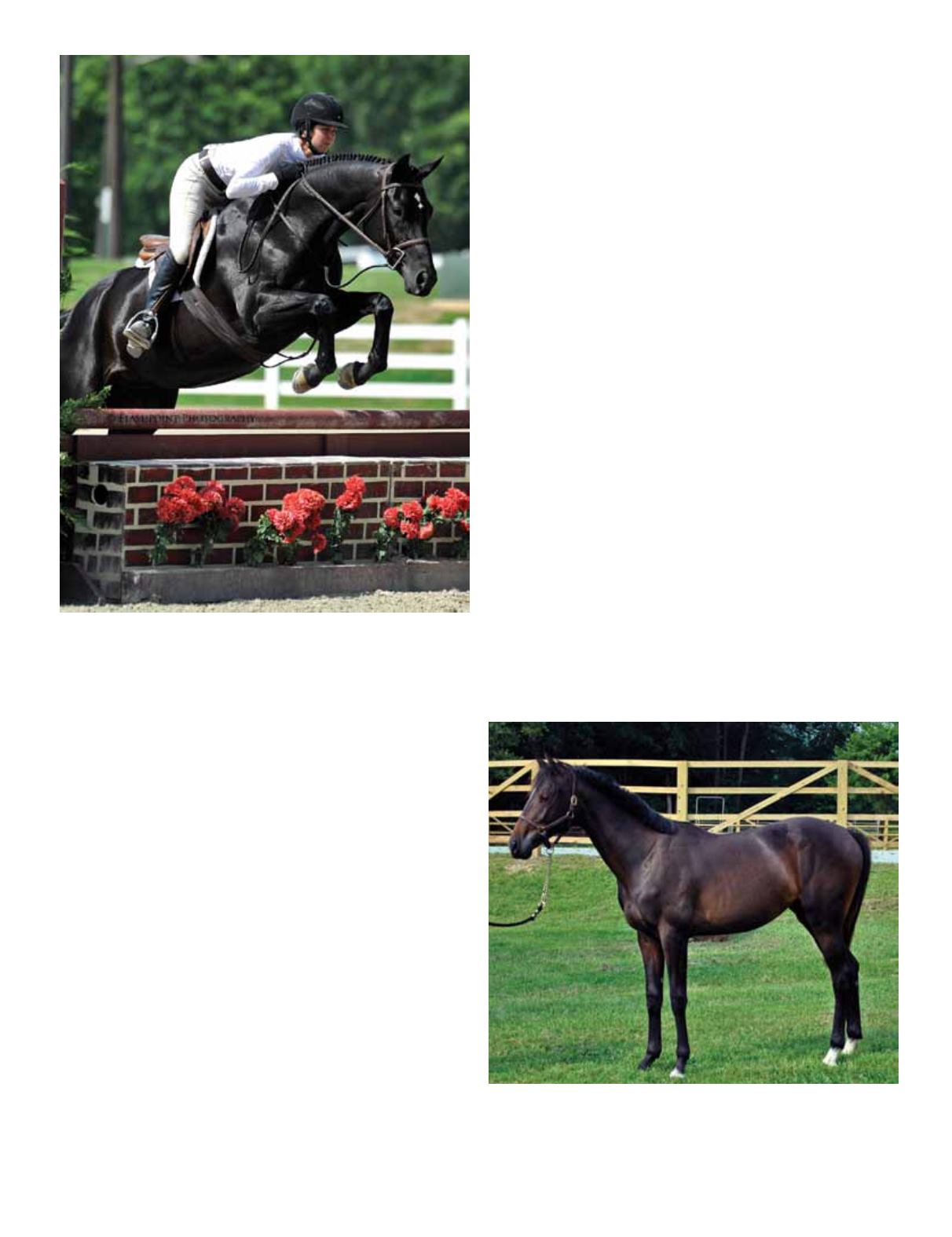
140 SIDELINES JANUARY 2014
FOR HORSE PEOPLE • ABOUT HORSE PEOPLE
MS McKinna (Numero Uno–Shakira Do Jacare) – 2012 First
Premium BWP filly: Shakira’s first foal is athletic with a winning
spirit, both vital for a top-level jumper. At her the BWP Keuring,
judges remarked on the filly’s modern body type and light, free
movement.
Photo by Sarah Owen
New Orleans – 2007 Hanoverian filly bred by Edgewood
Meadow Farm as Fleuretta EMF (Fabuleux-Fun Choice xx) and
bought in 2009 by Muny Sunk Stables – ridden by Liza Towell
Boyd, qualifying for the inaugural 2013 USHJA Pre-Green
Incentive Program (PGIF) Finals.
Photo by Flashpoint Photography
Family Heritage
The Vanneck family has been involved with horses for several
generations. They started breeding Standardbreds in the 1980s.
When Christine’s grandmother, Barbara Vanneck, died, and the
demand for Standardbreds trickled out, the family operation shut
down. However, Christine had horses in her blood, which she
passed on to her daughter, Sarah.
Sarah started riding at the age of six and spent several years
at Helen Varble’s Wellington Show Stables and Riding School
before working with Judy Young in Camden, South Carolina for
the duration of her hunter career. She moved on to ride for about
four years with Betsy Pack at Stoney Knoll Farm in Columbus,
North Carolina. For three years, she did the jumpers under the
tutelage of Sergio Campos.
“There were a lot of highlights in my showing career, various
year end and USEF zone accomplishments, but here’s what is
really prominent in my memory,” recalled Sarah. “Winning the
2005 Barry Lane Memorial Children/Adult Grand Prix with Arko
– there were about 90 in the class that year and I was stressed,
trying to run back and forth between the jumper ring and the
hunters. She Can Dance was a fiery little mare I rode and we had
an enormous amount of success together. One summer in Tryon
we won the classic two weeks in a row and that same year at
Blowing Rock we won the classic and received circuit champion
as well. Another accomplishment was getting on Shakira for the
first time ever and going directly into the show ring – that was an
experience I will never forget.”
Muny Sunk Promises and Delivers
A career-ending shoulder injury in spring 2012 forced Sarah to
retire from showing, but that doesn’t mean she stopped riding.
Now 21, Sarah divides her time between working with the horses
and earning her college degree in Landscape Architecture. Her
mother, on the other hand, acquired so much hardware in her
neck from surgical repairs that doctors begged her to give up
riding. Christine admits that she cheats once in a while (don’t tell
anyone).
Christine and Sarah bring a substantial amount of pragmatic
horsemanship to their partnership acquired from years of
“continuing education” in the field, in the barn, and on the show
circuit. They do everything they possibly can to provide the best
care and support system for their horses 24/7, day in and day
out. To oversee the foaling process, they bring in Rose Maguire,
an experienced vet-tech with more than 3,000 deliveries to her
credit. “Breaking” isn’t quite the term for what happens at Muny
Sunk when the youngsters feel Sarah’s weight on their backs for
the first time, because they have been so well trained since birth.
“I’m still starting the babies, just no more competitive riding,”
Sarah said. “I bring the babies along from start to walk, trot and
canter so that they listen well, have manners and move off your
legs. I do all the flat work to prepare them for jumping and when
they’re ready, mentally and physically, we send them off to the
most suitable trainer to get started over fences.”
To continue Sarah’s work with the youngsters, Muny Sunk
utilizes reliable professionals for training over fences and showing
– hunter riders such as Liza Towell Boyd and Don Sheehan,
three-day eventer Beth Perkins and jumper rider David Jennings.
“We like to match the personality of the horse to how the
professional rides,” Sarah explained. “I like a good foundation of
dressage, because it is so helpful in the jumper ring. We want our
horses to flex into the rider’s hand, to move laterally, to extend
and to collect. Dressage helps strengthen and develop the horse
for jumping. We breed from our own knowledge and experience
in order to produce versatile and athletic horses. We look for the
right stallion for each mare, but what the offspring is suited to do
really depends a lot on the mare and how the foal develops.”


